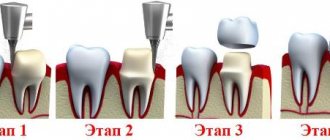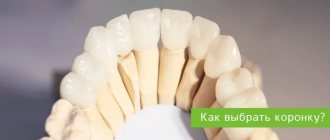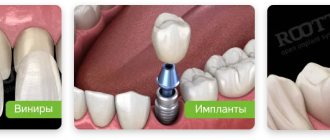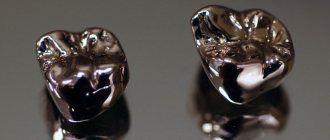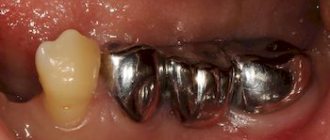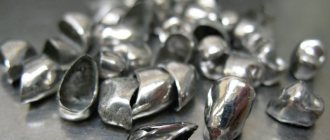Crowns are one of the types of dentures that can be used to restore lost or severely damaged teeth. Crowns are used in classical prosthetics and are placed on implant abutments after dental implantation.
Crowns are always selected taking into account a number of factors, and the area of the tooth that needs to be restored is always taken into account. What should crowns be like for chewing teeth? Let's look at this important issue together.
Structural materials in prosthetics
A modern dentist has a sufficient amount of materials for making dentures in his arsenal.
In modern prosthetics, materials such as: Plastic are used. Used for the manufacture of temporary crowns, and removable acrylic and nylon structures. Plastic products do not last long, so they will need to be replaced after a while.
Metal. Gold-containing and cobalt-chromium alloys are widely used. Metal crown frames and clasp dentures are very common.
Zirconium. Zirconium oxide and dioxide are ideal materials for restoring dentition in the chewing area. The ceramic coating of zirconium crowns gives the product a natural shine.
Ceramics. This material is valued for its properties that are as close as possible to natural tooth enamel. For ceramic products, you can easily choose the desired shade. The main disadvantage of ceramics was previously considered to be low strength, but with the beginning of the use of sodium disilicate in prosthetics, this parameter improved. A good example of the use of ceramics is E-Max crowns.
Which dental prosthetics is better and cheaper is a question that only his attending physician can answer for each patient. Much depends on the location of installation - anterior or chewing teeth, the level of qualifications of the specialist and the nuances of a specific clinical situation.
Dental crowns: criteria for choosing the best option for prosthetics
When choosing the best crown to restore a tooth, the following criteria will definitely be taken into account:
- The degree of tooth decay;
- The area of the dental unit that needs to be restored;
- The patient's wishes regarding the aesthetics of the result.
The location of the tooth that needs to be restored with a crown is a very important criterion when selecting it, because our teeth - the front and chewing ones - are subject to different loads. The chewing teeth are regularly subjected to a heavy load every time we eat something, and therefore the crown installed on the back chewing tooth must be strong and resistant to mechanical stress.
IMPORTANT: If your chewing tooth is severely damaged - more than 50%, it needs to be restored with a crown. Large fillings do not hold well, they can fall out or, even worse, break off along with part of the tooth. If the tooth splits in half or the root is damaged, the tooth will have to be removed and then implanted. Therefore, for damaged teeth, the best restoration option is to install a crown, not a filling!
But strength alone is not enough: a crown for a chewing tooth should help restore all the functions of a lost/damaged tooth, ensure proper distribution of the chewing load and have the longest possible useful life.
Taking into account all these requirements, the material for making a crown for a chewing tooth is selected. For prosthetics of back teeth, the following types of crowns are most often used: metal, metal-ceramics, zirconium. Which crown will be the best? To understand this issue, you need to study the characteristics, pros and cons of different types of crowns.
Prosthetics on implants
Implantation is a modern way to restore teeth. The operation consists of installing titanium pins on which removable or fixed dentures are placed. Implantation can be one- or two-stage.
With a one-stage operation, immediate loading of the implant and installation of artificial teeth is possible. Chewing function and aesthetics are restored immediately.
A two-stage installation requires a recovery period between the installation of the implant and the prosthesis. Complete restoration of chewing function and aesthetics is possible only after the implantation of the structure.
Also, prosthetics on implants can be removable or non-removable.
For removable prosthetics, a two-stage method is used. Abutments are installed only after osseointegration and are selected depending on the type of fastening, which can be locking or beam.
Installing permanent structure on an implant allows you to restore one or more teeth. The implementation of the design can be one-step or stage-by-stage. The non-removable method allows you to install a prosthesis without grinding or any damage to adjacent teeth.
Features and benefits of implantation
Advantages of Zygoma segment implantation
| ADVANTAGE | HOW IS IT ACHIEVED? |
| Instant prosthetics | The prosthesis is installed within a maximum of 72 hours, that is, no later than on the 3rd day. This is a mandatory condition of the protocol, since the prosthesis not only replenishes the aesthetics and functionality of the dentition, but also acts as a stabilizer for installed implants, protecting them from displacement under chewing load |
| Refusal of sinus lift | Using the zygomatic bone to fix implants allows you to avoid performing a sinus lift to build up the maxillary bone tissue. This significantly simplifies the rehabilitation process and reduces the overall treatment time |
| Durability of implants and prostheses | Since zygomatic implants were originally developed for the rehabilitation of patients with complex clinical situations, the reliability of their fixation is at the highest level. Prostheses can be easily changed if necessary without replacing installed implants |
| Precise positioning of implants | As with any other implantation method with immediate loading of the prosthesis, 3D computer modeling is used for planning. Additionally, a plastic dummy of the jaw system is created on a 3D printer - with its help, the doctor once again plans the implantation process, but using a real model |
| Quick adaptation and no discomfort | The implants are securely fixed and instantly loaded with the prosthesis. The design is created taking into account the bite, occlusion and position of antagonist teeth, so the prosthesis is as comfortable as possible and does not cause inconvenience even when chewing food |
| Easy adaptation of the method for complete prosthetics | The main feature of this protocol is that it can be easily converted into another method of dental implantation. This may be necessary after removing the remaining living teeth on the upper jaw. You can install an additional 2 or 4 implants (two in the lateral area, two more in the frontal area) and secure a complete fixed prosthesis designed for the entire dentition |
| Guaranteed implant survival | When installing implants, to obtain a guaranteed treatment result, plasmolifting is additionally used (PRF membranes from the patient’s own blood with a high platelet content), as well as Bio-Gide collagen membranes (the patient’s autologous bone mixed with a preparation based on deproteinized bovine bone with a high content of mineral components) |
By number of missing teeth
Depending on the number of lost teeth, a specific prosthetic method is selected.
For minor losses in the dentition
It is advisable to use acrylic, clasp and bridge prostheses. The design on implants will also always remain relevant.
With complete edentia
fixed prosthetics will be more effective. The technology of prosthetics on implants “All-on-4” and removable structures on pins are considered the most effective methods of restoring dentition with significant losses. In some cases, the use of economical versions of acrylic or nylon is justified, but due to insufficiently reliable fastening in the oral cavity and uneven load distribution, orthopedists do not recommend them so often.
How much do upper dentures cost?
The cost of services for the manufacture and installation of a prosthesis depends on many factors. These include:
- type and size of structure;
- complexity of the denture system;
- manufacturing materials;
- the presence of expensive fittings in the design.
The most expensive option remains prosthetic systems on implants. Classic removable upper partial dentures are less expensive, and the cheapest ones are plastic (acrylic) models with plastic crowns.
Prices for permanent structures also vary widely. Crowns remain the cheapest, and ultra-thin lumineers remain the most expensive.
By mounting method
In modern dentistry, various means of fixation are used. The comfort and duration of getting used to the structure will depend on the chosen method and quality of fastening. The orthopedic surgeon selects specific methods of fixation taking into account the individual clinical situation and the chosen method of prosthetics.
Creams and powders are considered one of the more reliable means of fixing removable dentures. A special product is applied to the denture, which is then pressed tightly to the oral cavity. Creams are recommended for patients with increased salivation, and powders are used for low salivation. If the structure of the jaw is abnormal, orthopedic doctors recommend using fixing strips.
Clasp-type dentures are secured using attachments or clasps. Alveolar processes are also used, which provide additional fixation. When putting on a removable denture, reliable fastening provides a suction effect.
Stages of installing a crown on a chewing tooth
- Diagnostics
– a comprehensive examination (orthopantomogram, 3D tomography), the dentist determines the general condition of the oral cavity, identifies dental problems, the presence of contraindications, draws up a treatment plan, and selects the optimal orthopedic design. - Preparation
- sanitization of the mouth (removal of plaque, tartar), treatment of teeth and gums (according to indications). The tooth is prepared for covering with a crown - the enamel is prepared, giving the stump the desired shape, the nerve is removed, the canals are filled, and, if necessary, the root is strengthened with a pin or inlay. To install zirconium structures, minimal tissue grinding is required; at the ILATAN clinic, a dental microscope is used for preparation, which allows you to remove enamel within a fraction of a millimeter. - Casts
- the doctor takes impressions of the patient’s jaws, from which a prosthesis is made in the laboratory. To protect the tissue, a temporary plastic crown is fixed to the prepared tooth. - Installation
- the finished crown is tried on, adjusted if necessary and fixed to the support with dental cement.
Which prostheses are better according to indications and budget?
An orthopedic surgeon will tell you which dental prosthetics are better and cheaper, and whether it is worth saving on treatment at all in each specific case.
The cost of prosthetics depends on the number of missing teeth, the type of design chosen and the level of qualification of the specialist. As a budget option, a good choice is an acrylic prosthesis; you should not remember about its fragility and possible allergic reaction. It is also worth considering nylon - it is softer and does not rub the gums.
More expensive options are clasp dentures with clasps or locks. In the second case, the fastening will be strong, but invisible in the mouth.
The most expensive designs are ceramic and zirconium. They are distinguished by excellent aesthetics and performance parameters.
Metal crowns
These crowns can be called the best for prosthetics of chewing teeth only in terms of price: it will be the lowest, and then only if the crown is made of an alloy of ordinary metals. If the crown is made of gold, its price will be equal to the cost of products made of ceramics and zirconium.
Metal crowns are durable and this quality can also be attributed to the advantages of this option, but there are still more disadvantages to prosthetics with metal crowns. Patients are often allergic to metal crowns; they can cause a galvanic effect, in which a person constantly feels the taste of metal in the mouth. To install metal crowns, you have to remove a fairly large amount of tissue from the tooth being ground, and this is bad, because the more a tooth is ground, the more fragile it becomes.
Installation of metal crowns can cause increased abrasion of antagonist teeth and, of course, metal crowns have poor aesthetics. Such a prosthesis is always clearly visible in the mouth. Aesthetics is not a determining factor when it comes to prosthetics for back teeth, but if you want the crown on a chewing tooth to not stand out from the background of other teeth, it is better to initially consider options for crowns made from other materials. Since metal crowns have much more disadvantages than advantages, we cannot call them the best, and we do not offer them to patients of our dental clinic in Moscow - “Aesthetica”.
FAQ
— Should I be afraid of allergic reactions?
An allergy to dentures is possible, but it is quite rare. Before installation, the patient undergoes a predisposition test. Based on the results of a vegetative resonance study, an orthopedic doctor determines sensitivity to various materials used in prosthetics. This method is 90% reliable.
— Is it necessary to use fixing compounds when wearing removable dentures?
Removable structures are “sucked” to the surface of the oral cavity, but for additional fixation you can optionally use creams or powders.
— Is it possible to sleep with removable dentures?
In the first 2-3 weeks, dentists even recommend not removing the structure at night in order to speed up the adaptation process. After the adaptation period, the choice remains with the patient himself - place the prosthesis in a special solution before going to bed or leave it in the mouth.
— When there are no teeth at all, which prosthesis is better to put in?
For complete edentia, the best option is fixed dentures on implants or prosthetics using the All-on-4 method. High aesthetics and durability will be important advantages. As an economical option, you can consider an acrylic prosthesis or acry-free.
Disadvantages of the method
Zygomatic implantation, no matter how many implants are used to restore teeth, places the highest demands on the experience and professionalism of doctors.
We not only practice, but also teach others!
Smile-at-Once is an immediate loading implantation university in Russia. We are the only ones who know and apply all methods, and not just one.
More details
“You can only trust zygomatic implantation to implant surgeons with extensive experience, and even better – to maxillofacial surgeons. We can say that the protocol using zygomatic implants is the gold standard of implantology in general, since it allows for the rehabilitation of those patients who, 7-10 years ago, were doomed to a toothless life and were content exclusively with removable dentures. And it’s not just about the complexity of installing zygomatic implants, but about compliance with all the requirements of the protocol, careful study of the entire process, and verification of every detail. With any approach, 90% of success depends on the doctor, and when performing zygomatic implantation, this figure reaches almost 100%,” adds Vladimir Anatolyevich Put.
Another disadvantage of the protocol is its higher price compared to alternatives. But on the other hand, there are also wider opportunities in terms of using the technique in conditions of very extreme bone tissue atrophy.
Types of fixed dentures
This type of prosthetics is indicated in the case of incomplete edentia - the absence of one to three teeth or their fragments. Its essence is to fix prosthetic structures on hard tissues using special cementing compounds. Fixed dentures can be temporary or permanent; they are made of zirconium dioxide, ceramics, composite materials, metal, and plastic.
Installation of this type of prosthesis allows you to solve a variety of problems. With the help of bridges, dental defects such as the absence of up to 3 adjacent teeth are eliminated. Cracks or chips of the enamel are masked with overlays - veneers or lumineers, which are firmly attached and prevent further destruction of hard tissues. In case of significant damage to the molars, inlays are installed instead of fillings. In case of partial or complete loss of the crown, an artificial analogue is placed.
Crowns
They are caps made of various materials that are hermetically placed on a specially prepared natural tooth. Preparation consists of preliminary treatment, depulpation (if necessary), and grinding. After preparation, an anatomically shaped prosthesis is made from the impression taken, and its temporary installation is performed. After a month, the dentist eliminates the identified deficiencies of the artificial crown and performs permanent fixation with medical cement.
Dental crowns
This type of prosthetics is performed using various materials:
- Metal – alloy of cobalt with chromium, precious metals. It is used in modern dentistry only for prosthetics of chewing teeth, since it looks unnatural. Metal crowns are the most durable and also the cheapest (if they are made by KHS).
- Metal-ceramics is a combination of a metal base with a ceramic coating. A more expensive and aesthetic option, not inferior in strength to the previous one.
- Ceramics is lithium disilicate, which is a durable material that fully matches natural tooth enamel in transparency and color.
- Zirconium dioxide - the best dentures that can be made are made from it - durable, aesthetic, but expensive.
- Plastic - used as a temporary overlay or for cladding a metal structure. It quickly darkens, deteriorates, and stains, but is very cheap.
Crowns are the optimal way to restore a tooth that is more than half destroyed. Installing a crown restores the ability to chew food properly and makes your smile aesthetically pleasing.
Bridges
Fixed orthopedic structures designed for prosthetics of 1-2 (less often three) dental units in a row. Longer products are impractical because they do not bear the chewing load and do not have increased strength. Bridges are a series of monolithic crowns that are attached to supporting teeth or implants. They are made from modern materials - metal ceramics, zirconium dioxide, and metal. Depending on the method of fastening, they are divided into several types.
Adhesive
Recommended for prosthetics if you need to preserve healthy abutment teeth. A design feature of this type of bridge is the fastening in the form of thin horizontal fiberglass plates, which are fixed on the inner surface of one’s own teeth. The design is quite durable, and also has a number of other advantages:
- aesthetics - the fastenings are invisible because they are located on the tongue side;
- safety – healthy teeth are not subjected to grinding:
- low price - formed by reducing material consumption.
The disadvantages of an abrasive prosthesis include its fragility (average service life is no more than 2 years), as well as the thickening of the supporting teeth. The last factor is a consequence of applying fastenings and takes some time to get used to.
Cantilevered
Suitable for eliminating a single defect, since only the teeth on one side are used as support. The supporting units (one or more) are ground, and a crown with a console made of zirconium or metal-ceramics is fixed on them. Since this type of fastening cannot be considered sufficiently reliable, cantilever bridges can only replace incisors with canines.
This design lasts about 5-7 years, but does not slow down bone tissue atrophy and is not highly durable. In addition, the supporting tooth gradually shifts, so consoles are placed only when it is impossible to use the teeth on both sides as support. For the same reason, this type of prosthetics does not correct end defects.
Composite
A bridge of this type is placed in cases where the axes of the supporting teeth are not parallel to each other. The structural elements are movably connected using hinges, clasps, and the “groove-ball” system. The main advantage of a composite bridge prosthesis is the possibility of prosthetics of inclined dental units. In addition, they are quite durable (last 12-15 years) because they are made of metal.
Combined
Solid metal dentures are characterized by increased strength and also do not require significant grinding of the teeth. However, due to their low aesthetic appeal, they are used for prosthetics exclusively for molars. If part of the prosthesis is visible, metal can be combined with metal ceramics. For example, the crowns on teeth 7 and 6 should be made cobalt-chrome, and those on teeth 5 and 4 – metal-ceramic. This reduces the cost of making a prosthesis without compromising your smile.
Microprostheses
Microprosthetics are used for partial destruction of the crown, chips and damage to tooth enamel. It is an intermediate link between filling and installation of a prosthesis. Microprostheses are made of composite materials, metal, ceramics, and are fixed using cement or special glue.
Veneers and Lumineers
They are thin ceramic plates designed to correct defects in the front teeth:
- cracks;
- chips;
- spots;
- darkening of the enamel;
- gaps, irregularities;
- thinning of enamel.
Veneers are coverings for teeth
Lumineers with a thickness of 0.2 mm are more expensive, but have a service life of 20 years, do not require significant grinding of teeth, and are fixed with glue. Veneers are cheaper, but you will have to prepare about 0.7 mm of hard tissue, attach the plates with cement, and the service life of the lining is no more than 15 years.
Tabs
This method of prosthetics is suitable for restoring the crowns of chewing teeth. The orthopedic dentist makes an impression, with the help of which a microprosthesis is made from metal or composite. It is attached with cement and is several times stronger than conventional fillings. If the crown is completely destroyed, a metal or metal-ceramic core inlay is placed.
Dentures on implants
The best dentures that can be installed as quickly, efficiently, and for a long time are designs on implants. They are classified as conditionally removable, since only a specialist can remove or install them. The prosthesis consists of an artificial jaw with teeth, titanium pins, and abutments. Compared to traditional implantation, this prosthetic method has several advantages:
- installation in 1 day;
- no bone tissue augmentation required;
- can be placed without age restrictions;
- the number or condition of the teeth does not matter.
All-on-4 technology is suitable for prosthetics of both jaws. The procedure is performed one day after preliminary sanitation of the oral cavity. Installs two pins in the patient’s jaw in the front, without tilting, and two more on the sides at an angle. Abutments are attached to the artificial roots, and an acrylic prosthesis is attached to them.
All-on-6 is a variation of the previous technique, but using 6 implants. Suitable for people with significant atrophy, reduced bone density, and those with periodontal disease. Implantation using this method provides more reliable fixation, requires more materials, and therefore costs more.
Metal-plastic
They differ from metal-ceramic ones at a more affordable cost. At the base of the crown there is usually an inexpensive metal: stainless medical steel or an alloy based on it. The coating is some kind of polymer: plastic or acrylic. It is white in color, but its shine is slightly different from enamel. However, when the crown is deep in the mouth, it is not noticeable.
The disadvantages of such crowns are:
- Low strength - they cannot be chewed on something hard, they wear out quickly, and therefore are most often used as a temporary masking of a defect while a permanent prosthesis is being prepared.
- Also, the polymer may darken when exposed to any coloring substances (food coloring).
- In some patients, the polymer causes swelling and irritation of the gums.
- The likelihood of allergies is higher than when using other types of structures.
